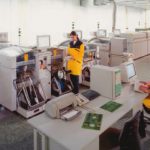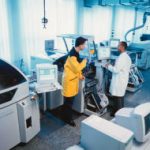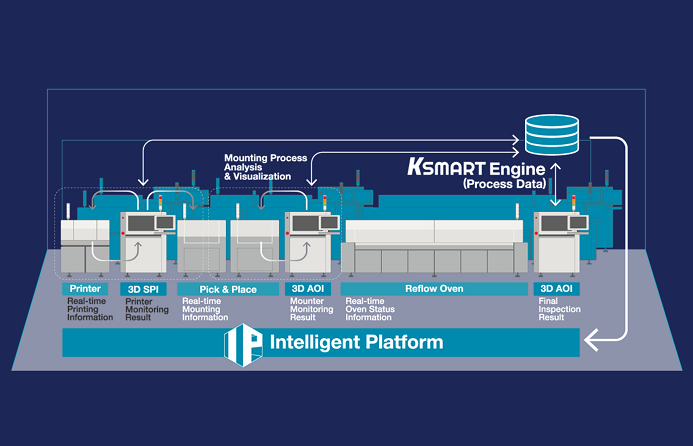Just a glance at a scenario: a user surprisingly encounters that theresults of component placement of the same origin cannot be correlated. A fatal situation, but the supplier and the user must establish to their annoyance that there are vital differences between lab conditions in development and the volume manufacturing of complex machines. Siemens however takes a quite different approach with its Siplace range: a stringent quality assurance concept assures the perfection of machines and thereby the product quality of the user at a maximum level.
Ekkard Mische, Process Improvement Siemens Demag
The approach for excellent quality and reliability with placement machines is neither simple nor does it automatically arise in the long chain extending from development up to the user stage. On the contrary, this embodies a stringent concept of design rules on the one hand, as is the case with Siemens, and, on the other, a careful sequence of control steps in the production of machines in order to clearly localize any possible ”blips or extreme cases”, and to rectify the cause thereof. Siplace placement machines are installed worldwide and have to meet maximum quality and reliability requirements regardless of where they are used. No question, component placement results can of course always be correlate. With a sophisticated sequence of controls, test runs and measuring procedures, Siemens ensures that users are able to operate with maximum machine performances and quality throughout the whole useful life of this system. It is ensured that the reliability of placement is always monitored and secured by means of a complete system of controls ranging from engineering, production and support performances through to the customer. Far more than 10,000 placement modules have now been installed across the globe under the Siplace brand name. This is also an indication of the fact that this quality assurance concept is contributing to securing high performance and placement security.
What is the sequence in the last production stage of Siplace component placement modules? Siemens’ production in Bruchsal/Germany delivers fully assembled and tested modules in standard version that are then configured in the Munich headquarters based on customer specifications available there. The placement machines in the Bruchsal assembly fab are monitored in their basic functions from A to Z by means of extended continuous operations with temperature cycles, and are controlled in full for compliance with the base parameters, e.g. the MTBF (mean time between failures). All the basic functions are therefore tested, and this is documented in the form of records accompanying delivery to Munich for final assembly. These strict quality concepts naturally apply to machine parts from suppliers as well. Siplace production is certified in accordance with DIN ISO 9001.
Modularity has an effect on test procedures
The placement modules are integrated in lines, and consequently they are configured in detail in Munich, based on the relevant line layouts. What is also extremely important with the tests, which are subsequently carried out on placement accuracy, is the high modularity of the Siplace placement module that is fitted with different heads and cameras for the vision systems. The advantage of such high modularity is that instead of buying an additional machine (high capital and training costs), only a head refitting is necessary if changes in the customer’s product spectrum occur which can also be effected in the field directly. With the subsequent test and calibration, that is something which can be done within a day.
For example, the Siplace S-25 HM high-speed module with 25,000cph (components per hour) can be fitted with 6 and 12-segment collect&place heads on its two placement portals. Various specifications are dependent on this: with the 6-segment revolver head ±80mm/4-Sigma, and with 12 segments ±90mm/4-Sigma. An extremely broad component spectrum of 0201s, advanced packages (flip-chip, BGA, CSP, etc.) up to QFPs with 55 or 92mm is processed by the Siplace F5 HM high-end placer. The single-portal machine (with a maximum of 10,000 cph) can be fitted with a pick&place head for large ICs or a 6 or 12-segment revolver head depending on specification, with precision in the order of 60mm/6-Sigma. It is clear that the individual configuration is the ”be all and end-all” with machine finishing, and the exact controls of placement security, throughput/speed, performance and precision are therefore dependent on this. Siemens required some 220 million genuine components for these tests last year.
Four different test runs are made as part of these final quality assurance procedures, ranging from the receipt of the base module through to delivery of the complete configuration to the user. Three of these test runs are obligatory (benchmark, machine capability and a 4-hour run-in) and an additional verification (placement force and coplanarity) is only carried out at request. The three standard tests run through all machines with no ”ifs and buts”, and records are kept on the results so that the necessary transparency is ensured bothon the run and in dealings with the customer.
Benchmark verifies basic functions
As a verification of the pre-production in Bruchsal, as it were, all placement modules are subject to a benchmark test first in Munich, together with the placement heads that have already been mounted for the respective machine configuration. In this process, up to 5760 type-0603 components (revolver heads) or approximately 150 PLCCs with the IC head are placed on boards with ”ideal” positions taking account of ”ideal” placement routes under idealized (adapted) conditions. This first QA control of a freshly configured mod-ule includes basic performance parameters, including any possible pick-up errors and the positioning time. The placement time is also measured, and the placement rate of the machine is calculated from this.
Machine capability: lowest tolerances in mind
The next important test to which a module has to be subjected is the machine capability. For this purpose, true-to-size glass parts are placed on a glass pane, which has previously been fitted with adhesive foil. The main effects on placement accuracy are analyzed in this way, namely standard deviation (Sigma) and the deviation of the average from the standard factor, thereby establishing the machine process capability index (cpk). Placement machines must have an index of at least 1.33 in order to ensure 4-Sigma capability. 6-Sigma capability is assumed in the event of even more stringent requirements that certainly represent the standard in a number of production processes. The index in these cases must be 2.0 or better. A production specialist is more interested in details of error limits relating to placement reliability (dpm – defects per million). This means that 60dpm are allowed with 4-Sigma, but only 0.002dpm within 6-Sigma. 6-Sigma is based on a very high level of component quality that manufacturers cannot maintain in practice. The supply quality of component corresponds more to the 4-Sigma level–this is also an excellent factor with a maximum of 60 defects out of one million.
1900 precise glass parts and 30 glass panes (300×300/200x300mm) are available for the machine capability test (MCT), so that the process capability is really determined, and not just any external effects. The prerequisite in this case is that all effects should be avoided for the analysis of the capability which are not attributable to the module itself. They are shown as a mismatch in XY and theta. Optical co-ordinate measuring gear whose linear glass scales have a resolution of 0.1mm, and whose uncertainty factor is in the area of 1mm, are used for the readings of the glass part placement accuracy. What dimensions of the placement tolerances are involved are illustrated by referring to the size factors. For example, if we take the average diameter of a hair (70mm), the IC head of the 80 F then places within these 45 positions which are only a few microns apart. A maximum tolerance of 50mm is specified for this placement head.
Acceptance run very close to practice
After the process capability has been determined, a test follows of the module under practical conditions. For this purpose, the calibrated placement module is operated in a 4-hour run-in. The placement is carried out on an aluminum PCB (layout deviations under ±25mm), with real components of all kinds ranging from 0402 to 1206, SOT23, MiniMelf, SO14 and PLCC28/68, and the pitch down to 0.3mm. In so-called corridors on the aluminum PCB, one identical component is placed alongside the other under normal production conditions. This has the advantage that even very small deviations become immediately visible, and the dpm value can be controlled without using sophisticated equipment. Throughput/speed is finally checked once again by determining placement times.
This test of placement reliability can also be carried out in the presence of a customer as a final control, shortening the acceptance procedure before delivery of a line. A placement force and coplanarity test is then only necessary for a few users at their request.
Maintenance and fine-calibration in the field
If service and maintenance is later necessary in the field, or a placement head has to be exchanged, both the practice-based placement on an aluminum PCB and the fine-calibration of the offset can be easily carried out. There are two options: the placement accuracy can be tested with extremely expensive measuring equipment, or by simply using the machine’s highly precise camera of the vision system. After extensive maintenance work, it has to be speedily and economically ensured that the module reaches the process capability values that have been originally specified. A number of precautionary measures have to be taken for compensating the placement offset which is important for an optimal machine capability index, and high precision requirements have to be observed. The idea is to utilize the placement machine as super-precise measuring gear because it has almost all the necessary functions for this purpose, i.e. a portal, camera, vision system and the appropriate software.
The glass panes for the fine-calibration are identical with those for the machine capability test and have four fiducials for this purposes, with their reciprocal tolerance being a maximum of ±5mm. The glass parts also have four fiducial marks. After the placement operation, the PCB camera of the module takes four images in the corners of the glass pane in which the fiducial marks of the board and the parts directly placed thereon are recorded. Based on these marks, the system automatically determines the offset and corrects it automatically, thereby writing correction factors in the calibration memory. There is no absolute measurement of tolerances in this process, but a relative recording. The calibrated camera provides details in the number of pixels between the individual points (passer marks) as a measurement of the accuracy but not the real distances. This means that the resolution and quality of the camera are exclusively important for this reading, and other influential factors such as the axis tolerances of the placement machines are efficient faded outat the same time. This is also followedby a practical placement on an alumin-um PCB in order to ensure that any de-viations can be immediately and reliably identified.
Consultancy ensures production quality
The customer benefit, which is based on better and more positive quality and reliability, is increased further by the support of the Technology Consulting Team that advises and supports users during the machine life. In addition to the other measures for ensuring a higher placement quality, further support is also available for optimizing the production process of a customer. These mainly relate to the following core areas of activity:
- a) Placement optimization – the user receives useful information on the configuration of the feedercarts and the feeder loading
- b) New product run – in this case, it isensured by examining the existing pro-duction equipment and installations that the customer meets the necessary technical prerequisites in order to include a new product with a high quality and quick ramp-up in his production range. All procedures and sequences are planned, and an introduction strategy is developed
- c) Process advice – this presupposes a high level of process expertise of the so-called all-rounder, being a competent partner for the customer in all questions of production procedures. He also knows which specialist he possibly has to involve in special cases
- d) Downtime analysis and logistics/environmental consultancy reveal potentials for increasing the productivity of the assembly process and documents the current status quo. Logistic problems relating to the production can be shown as part of the environmental analysis and are quantified, with corresponding solution proposals being developed
In summary, a high level of confidence has developed because of the comprehensive measures for quality assurance and the production success achieved thereby. Users can comprehend how many maximum requirements for placement reliability and performance Siemens has realized in offering high-grade support for cus-tomers and thereby safeguarding the quality of its placement modules over the whole usage period. Apparently, a viable and trustworthy basis is being established in the global environment because of this remarkable transparency and openness.
EPP 165
Zusammenfassung
Der Weg zu einer überragenden Qualität und Zuverlässigkeit bei Bestückautomaten ist weder einfach, noch ergibt sich dies zwangsläufig. Dahinter steckt vielmehr – wie im Beispiel Siemens gezeigt – ein stringentes Entwicklungskonzept und die sorgfältige Abfolge von Kontrollen in der Maschinenfertigung, um eventuelle ”Ausreißer” eindeutig zu lokalisieren und die Ursache zu beseitigen. Siplace-Bestückautomaten werden weltweit installiert und müssen unabhängig vom Einsatzort höchste Anforderungen erfüllen. Dabei müssen natürlich die Bestückergebnisse stets korrelierbar sein.
Résumé
Parvenir à la qualité et à la fiabilité dans le cas des automates à implanter les composants n’est ni simple, ni systématique. Comme le montre l’exemple de Siemens, cela exige un concept de développement sophistiqué et la réalisation soigneuse de contrôles dans la fabrication des machines en vue d’éliminer clairement les éventuels défauts et leurs causes. Les automates d’implantation Siplace sont installés dans le monde entier et doivent remplir les plus sévères critères quel que soit le lieu d’utilisation. Les résultats de l’implantation doivent bien entendu pouvoir être corrélés en permanence.
Sommario
Il percorso da seguire per ottenere qualità ed affidabilità di macchine di equipaggiamento non é né semplice, né automatico. Dietro a ciò, come mostra l’esempio della Siemens, si nasconde un rigido concetto di sviluppo e l’accurata sequenza di controlli nella produzione sulle linee, finalizzato al rintracciamento univoco di eventuali „scarti“ e alla soluzione della relativa causa. Le macchine di equipaggiamento Siplace vengono installate in tutto il mondo e devono soddisfare i massimi requisiti indipendentemente dal luogo di esercizio, permettendo comunque sempre di correlare i risultati dell’equipaggiamento.
Unsere Webinar-Empfehlung
Die Nutzung der 3D-Mess- und Prozessdaten bringt die Produktionssteuerung auf die nächste Stufe. Echte 3D-Messung ermöglicht KI-basierte Prozessmodellierung zur Vorhersage von Parameteränderungen und -defekten oder zur Ursachenanalyse bis hin zu einzelnen Werkzeugen und Best…
Teilen:













